Foreword / YouTube Video Review
Arendal loaned me this pair of speakers to review. They have not seen the review prior to publication.
The review on this website is a brief overview and summary of the objective performance of this speaker. It is not intended to be a deep dive. Moreso, this is information for those who prefer “just the facts” and prefer to have the data without the filler. The video below has more discussion with respect to the technical merits and subjective notes I had during my listening sessions.
< coming soon >
For help understanding the data, I encourage you to watch this video which discusses the implications of (some of) the data shown below:
Information and Photos
Some specs from the manufacturer can be found here.
- 2.5-way design
- 28mm Tweeter in waveguide
- (4) 5.5-inch midwoofers
- Sealed or ported option
- Dimensions: 83.75H x 16.3W x 28.5D cm
- 4-ohm nominal impedance
- Crossover Frequency = 120Hz / 1500Hz
- Spike/stand kit included
- Magnetic Grills included
- 60 Days “Buy & Try” return policy
Price is approximately $1699 USD for the pair.
CTA-2034 (SPINORAMA) and Accompanying Data
All data collected using Klippel’s Near-Field Scanner. The Near-Field-Scanner 3D (NFS) offers a fully automated acoustic measurement of direct sound radiated from the source under test. The radiated sound is determined in any desired distance and angle in the 3D space outside the scanning surface. Directivity, sound power, SPL response and many more key figures are obtained for any kind of loudspeaker and audio system in near field applications (e.g. studio monitors, mobile devices) as well as far field applications (e.g. professional audio systems). Utilizing a minimum of measurement points, a comprehensive data set is generated containing the loudspeaker’s high resolution, free field sound radiation in the near and far field. For a detailed explanation of how the NFS works and the science behind it, please watch the below discussion with designer Christian Bellmann:
The reference plane in this test is at the tweeter axis. Note: As shown in the above photos, when standing upright, the baffle is angled 5° as the typical seated ear-level height is higher up than the tweeter is mounted on the speaker. This means that, while the data is taken at the tweeter axis, the primary listening axis will be 5° above the tweeter axis. This can be adjusted mechanically though by adjusting the front to back spikes, there is a disc on the spikes that can be moved either over or under the spike bar which will change the angle for the listening axis.
Therefore, while the on-axis response shows a downward high-frequency slope, at the typical seated height, the on-axis response would be flat. This is important to keep in mind. There is no way to “correct” for this in the data without physically tilting the speaker forward 5° to flatten out the vertical axis response which is not feasible.
The speaker was tested in sealed configuration. A comparison to ported is provided later, however.
Measurements are provided in a format in accordance with the Standard Method of Measurement for In-Home Loudspeakers (ANSI/CTA-2034-A R-2020). For more information, please see this link.
CTA-2034 / SPINORAMA:
The On-axis Frequency Response (0°) is the universal starting point and in many situations it is a fair representation of the first sound to arrive at a listener’s ears.
The Listening Window is a spatial average of the nine amplitude responses in the ±10º vertical and ±30º horizontal angular range. This encompasses those listeners who sit within a typical home theater audience, as well as those who disregard the normal rules when listening alone.
The Early Reflections curve is an estimate of all single-bounce, first-reflections, in a typical listening room.
Sound Power represents all of the sounds arriving at the listening position after any number of reflections from any direction. It is the weighted rms average of all 70 measurements, with individual measurements weighted according to the portion of the spherical surface that they represent.
Sound Power Directivity Index (SPDI): In this standard the SPDI is defined as the difference between the listening window curve and the sound power curve.
Early Reflections Directivity Index (EPDI): is defined as the difference between the listening window curve and the early reflections curve. In small rooms, early reflections figure prominently in what is measured and heard in the room so this curve may provide insights into potential sound quality.

Early Reflections Breakout:
Floor bounce: average of 20º, 30º, 40º down
Ceiling bounce: average of 40º, 50º, 60º up
Front wall bounce: average of 0º, ± 10º, ± 20º, ± 30º horizontal
Side wall bounces: average of ± 40º, ± 50º, ± 60º, ± 70º, ± 80º horizontal
Rear wall bounces: average of 180º, ± 90º horizontal

Estimated In-Room Response:
In theory, with complete 360-degree anechoic data on a loudspeaker and sufficient acoustical and geometrical data on the listening room and its layout it would be possible to estimate with good precision what would be measured by an omnidirectional microphone located in the listening area of that room. By making some simplifying assumptions about the listening space, the data set described above permits a usefully accurate preview of how a given loudspeaker might perform in a typical domestic listening room. Obviously, there are no guarantees, because individual rooms can be acoustically aberrant. Sometimes rooms are excessively reflective (“live”) as happens in certain hot, humid climates, with certain styles of interior décor and in under-furnished rooms. Sometimes rooms are excessively “dead” as in other styles of décor and in some custom home theaters where acoustical treatment has been used excessively. This form of post processing is offered only as an estimate of what might happen in a domestic living space with carpet on the floor and a “normal” amount of seating, drapes and cabinetry.
For these limited circumstances it has been found that a usefully accurate Predicted In-Room (PIR) amplitude response, also known as a “room curve” is obtained by a weighted average consisting of 12 % listening window, 44 % early reflections and 44 % sound power. At very high frequencies errors can creep in because of excessive absorption, microphone directivity, and room geometry. These discrepancies are not considered to be of great importance.

Horizontal Frequency Response (0° to ±90°):

Vertical Frequency Response (0° to ±40°):

Horizontal Contour Plot (not normalized):
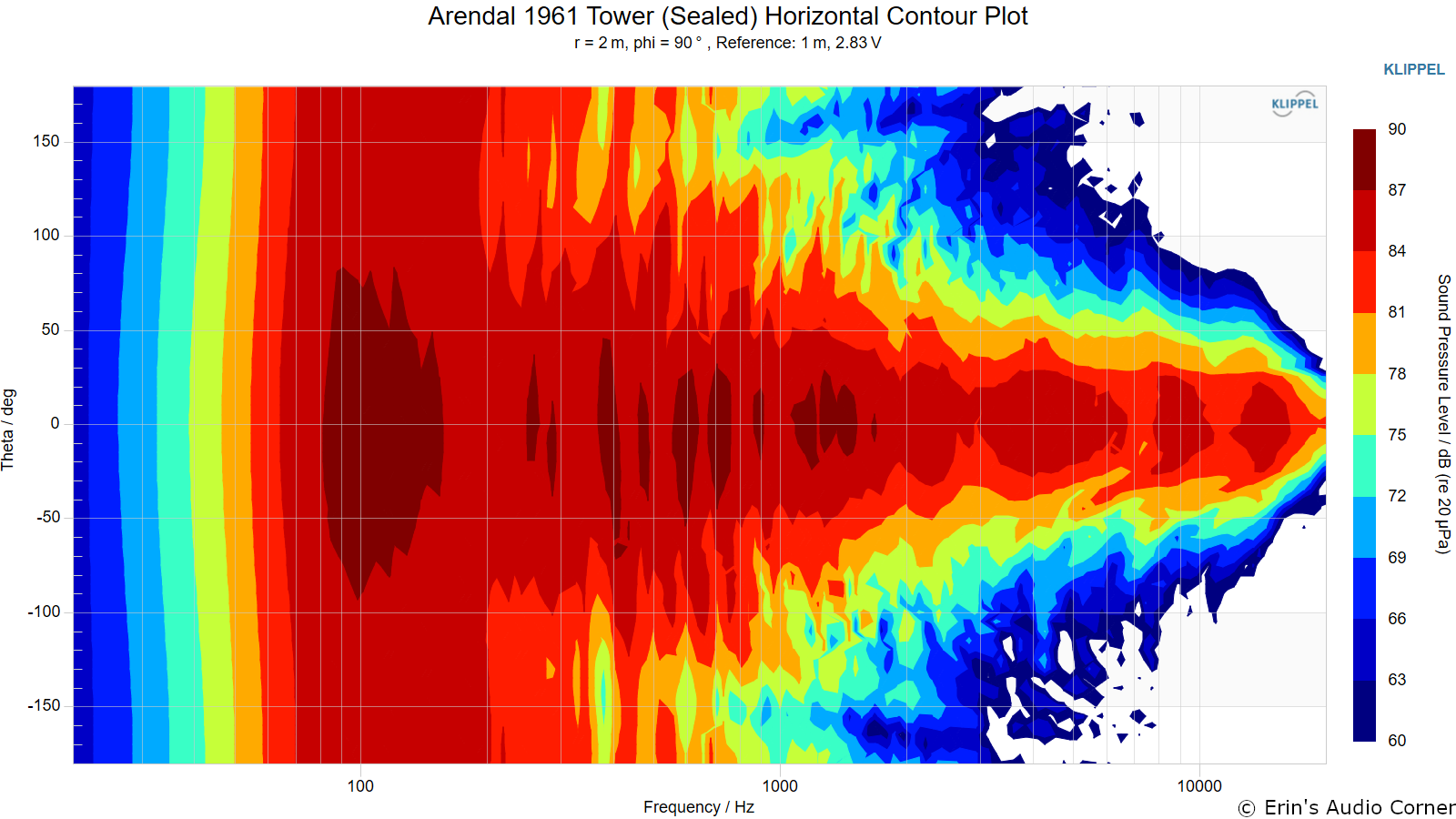
Horizontal Contour Plot (normalized):

Vertical Contour Plot (not normalized):

Vertical Contour Plot (normalized):
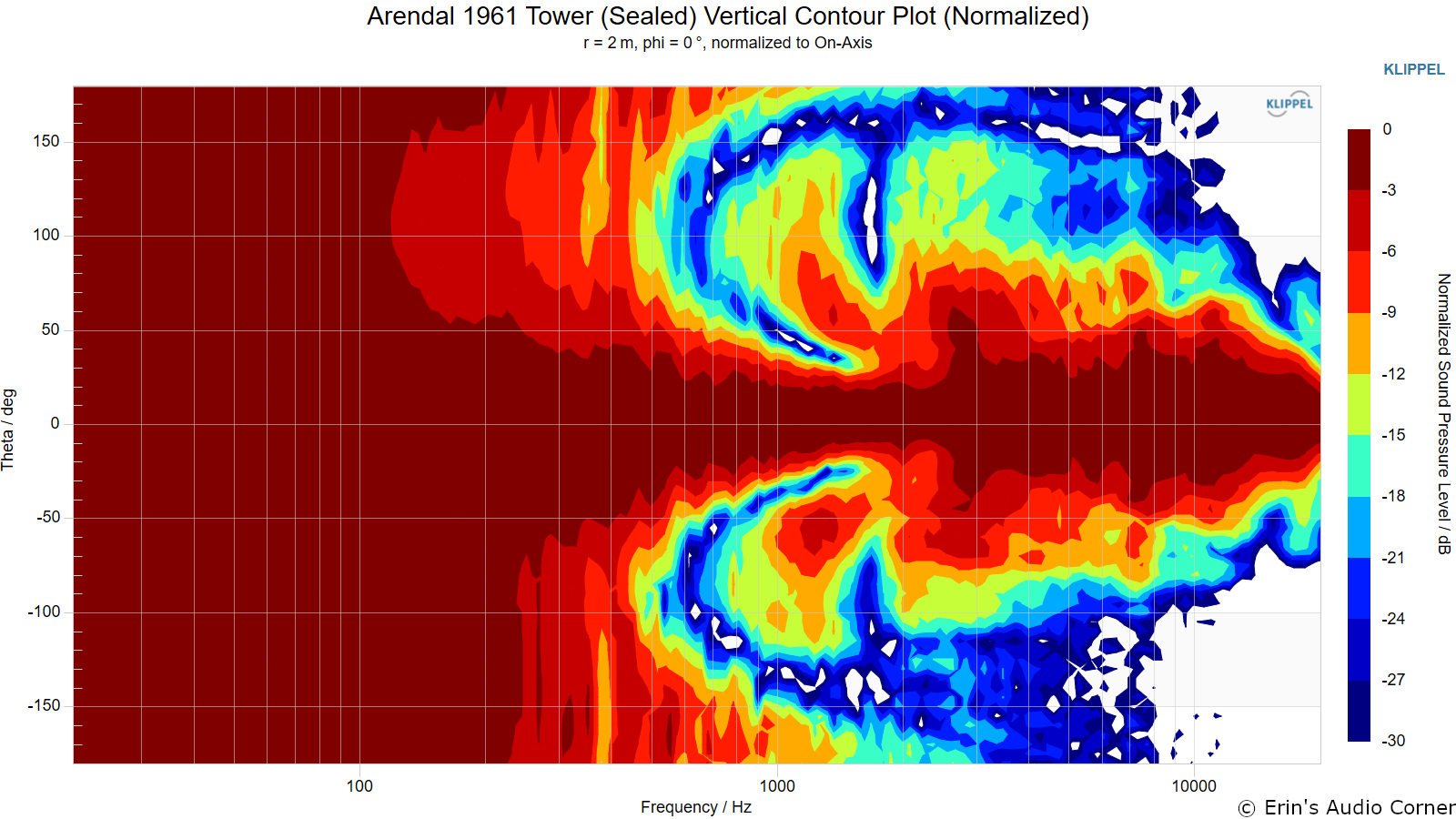
“Globe” Plots
Horizontal Polar (Globe) Plot:
This represents the sound field at 2 meters - above 200Hz - per the legend in the upper left.
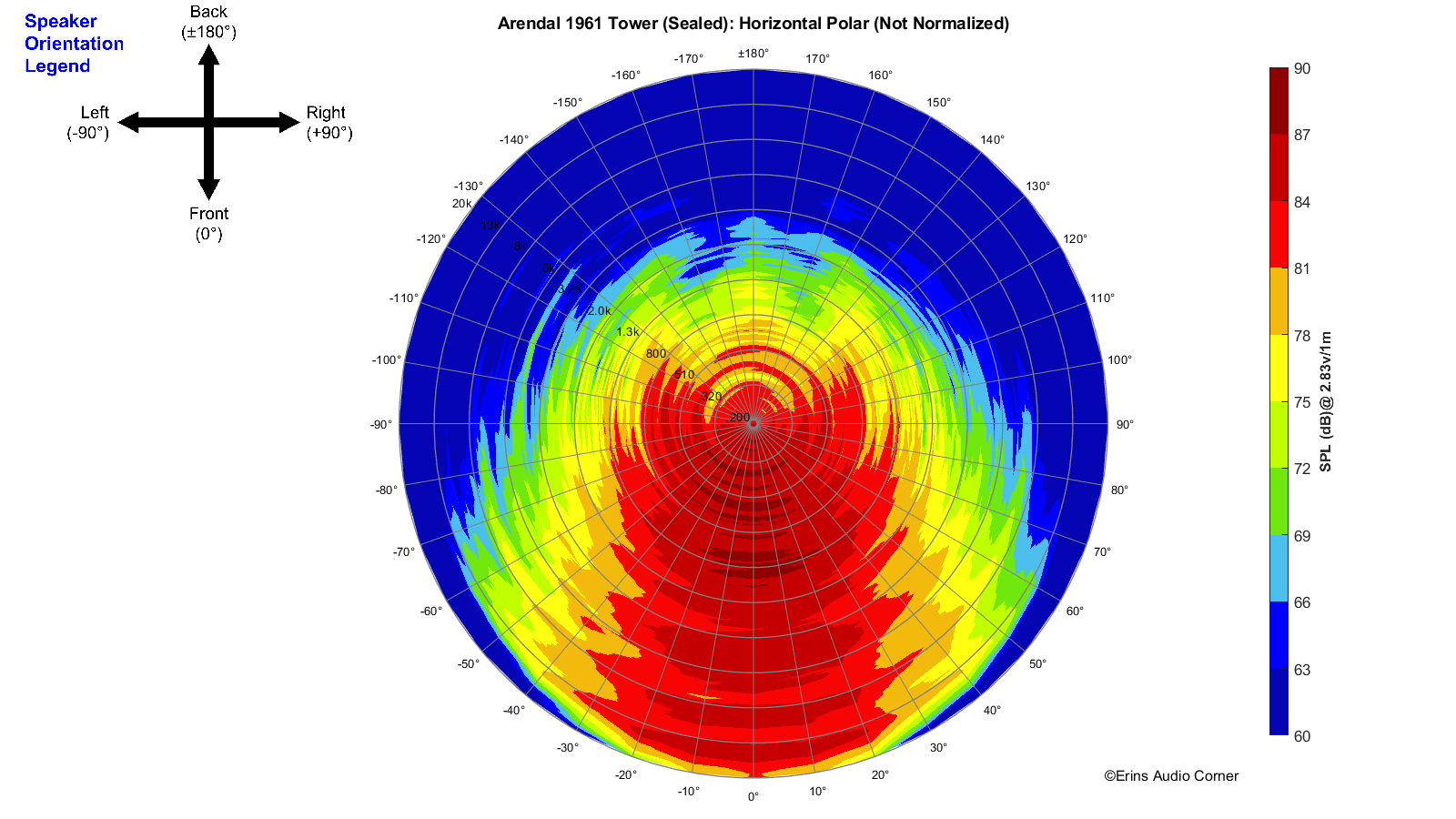
Vertical Polar (Globe) Plot:
This represents the sound field at 2 meters - above 200Hz - per the legend in the upper left.

Additional Measurements
On-Axis Response Linearity

Impedance Magnitude and Phase
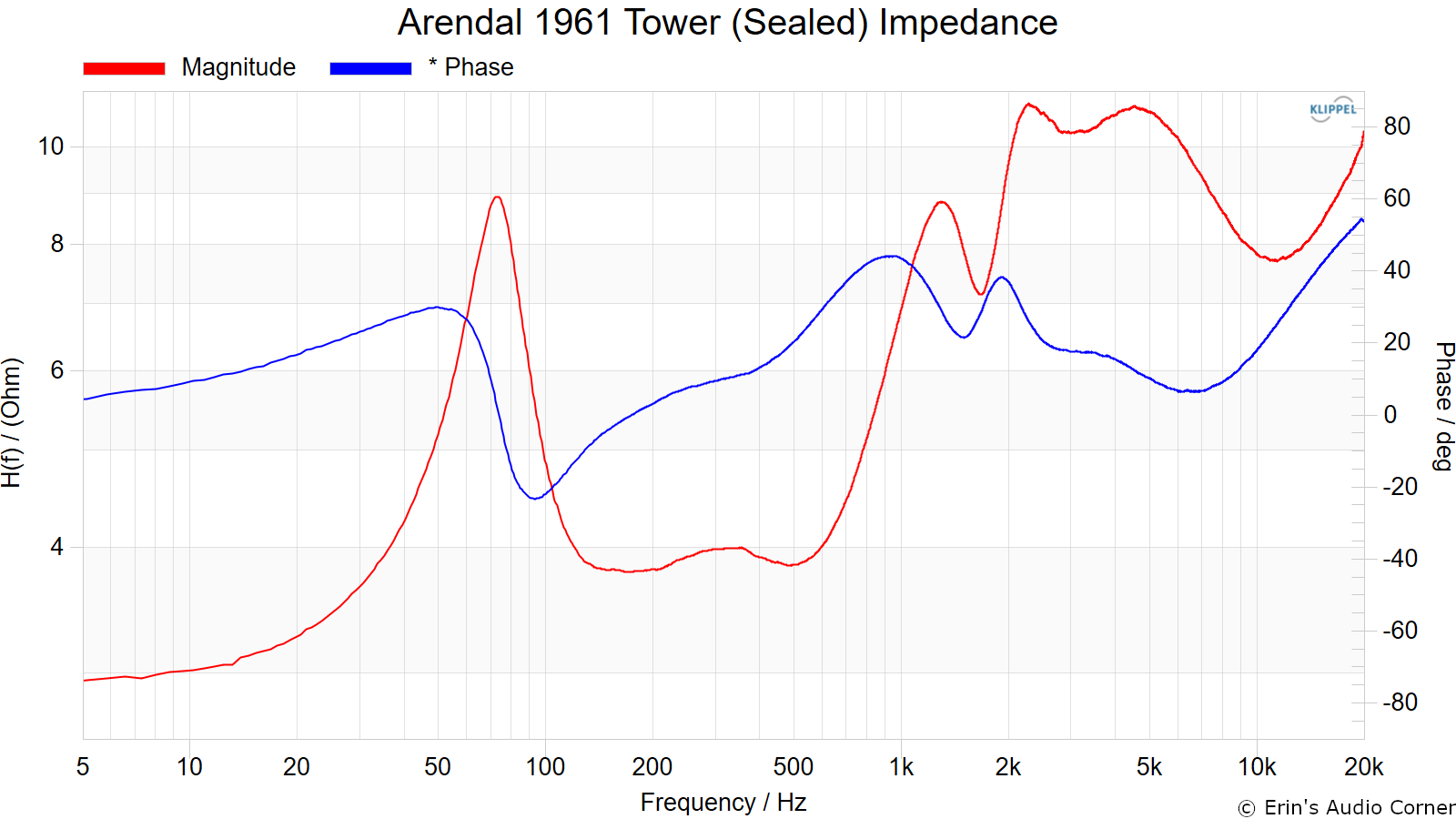
Harmonic Distortion
Harmonic Distortion at 86dB @ 1m:
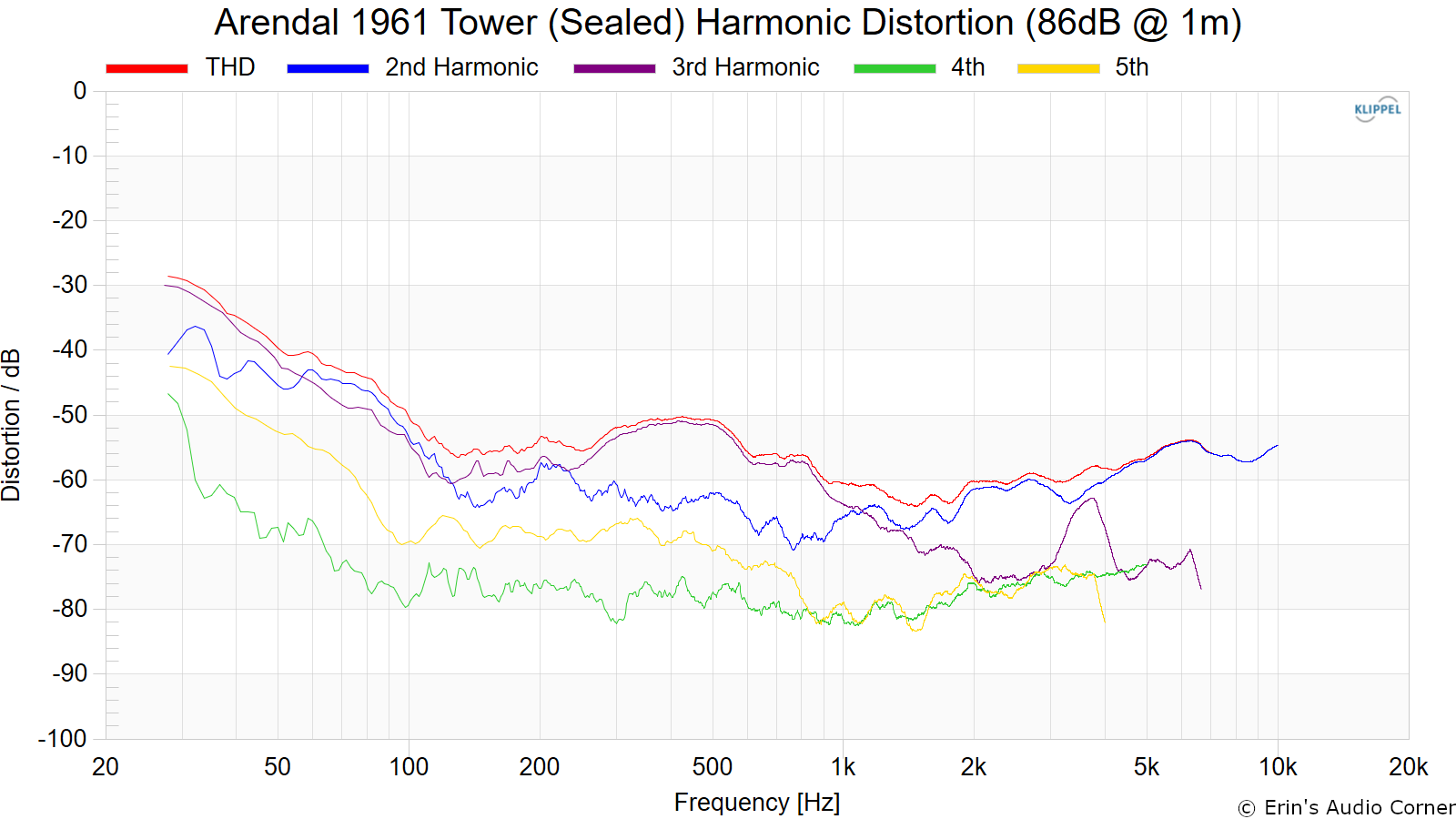
Harmonic Distortion at 96dB @ 1m:
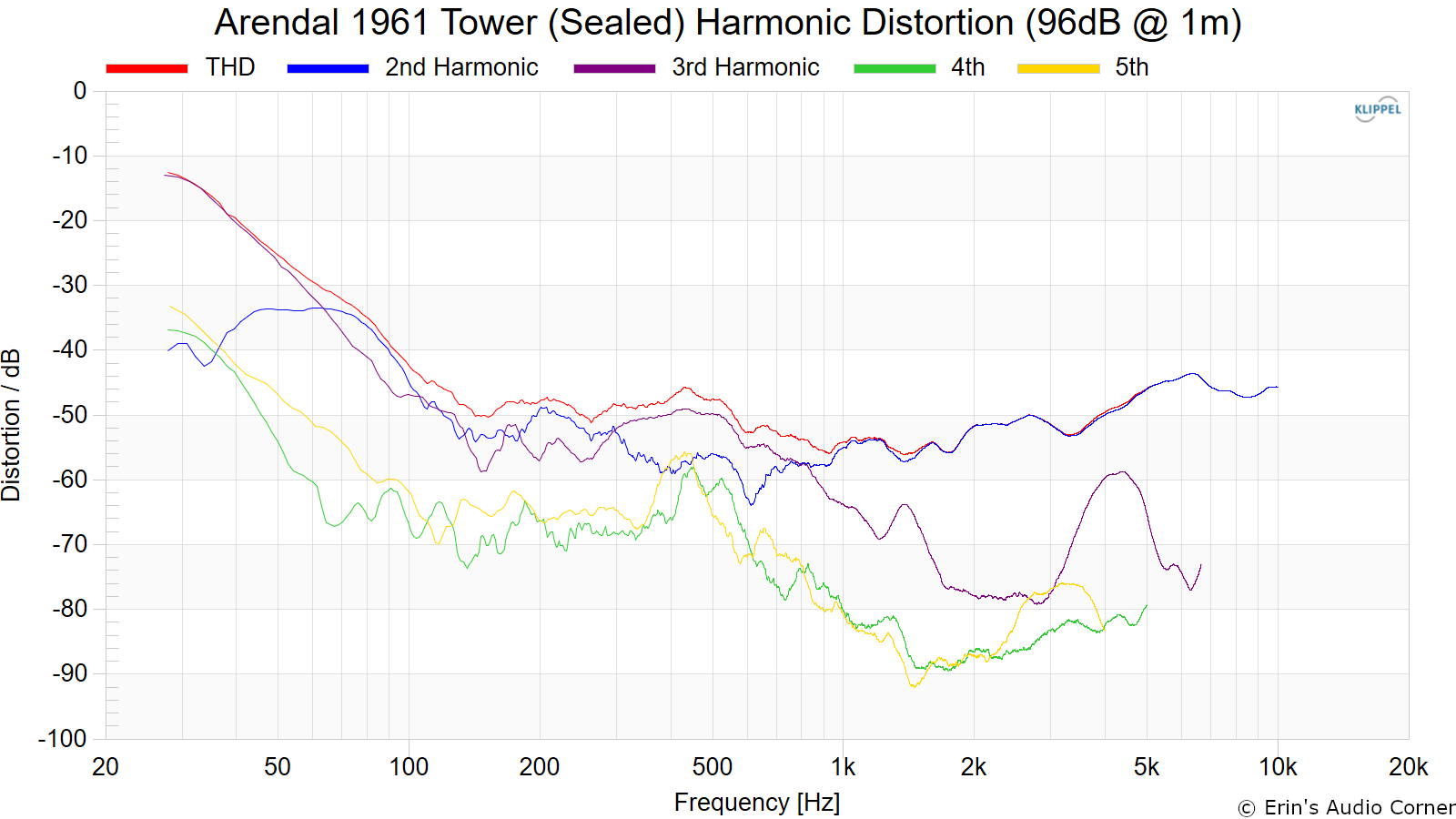
Dynamic Range (Instantaneous Compression Test)
The below graphic indicates just how much SPL is lost (compression) or gained (enhancement; usually due to distortion) when the speaker is played at higher output volumes instantly via a 2.7 second logarithmic sine sweep referenced to 76dB at 1 meter. The signals are played consecutively without any additional stimulus applied. Then normalized against the 76dB result.
The tests are conducted in this fashion:
- 76dB at 1 meter (baseline; black)
- 86dB at 1 meter (red)
- 96dB at 1 meter (blue)
- 102dB at 1 meter (purple)
The purpose of this test is to illustrate how much (if at all) the output changes as a speaker’s components temperature increases (i.e., voice coils, crossover components) instantaneously.
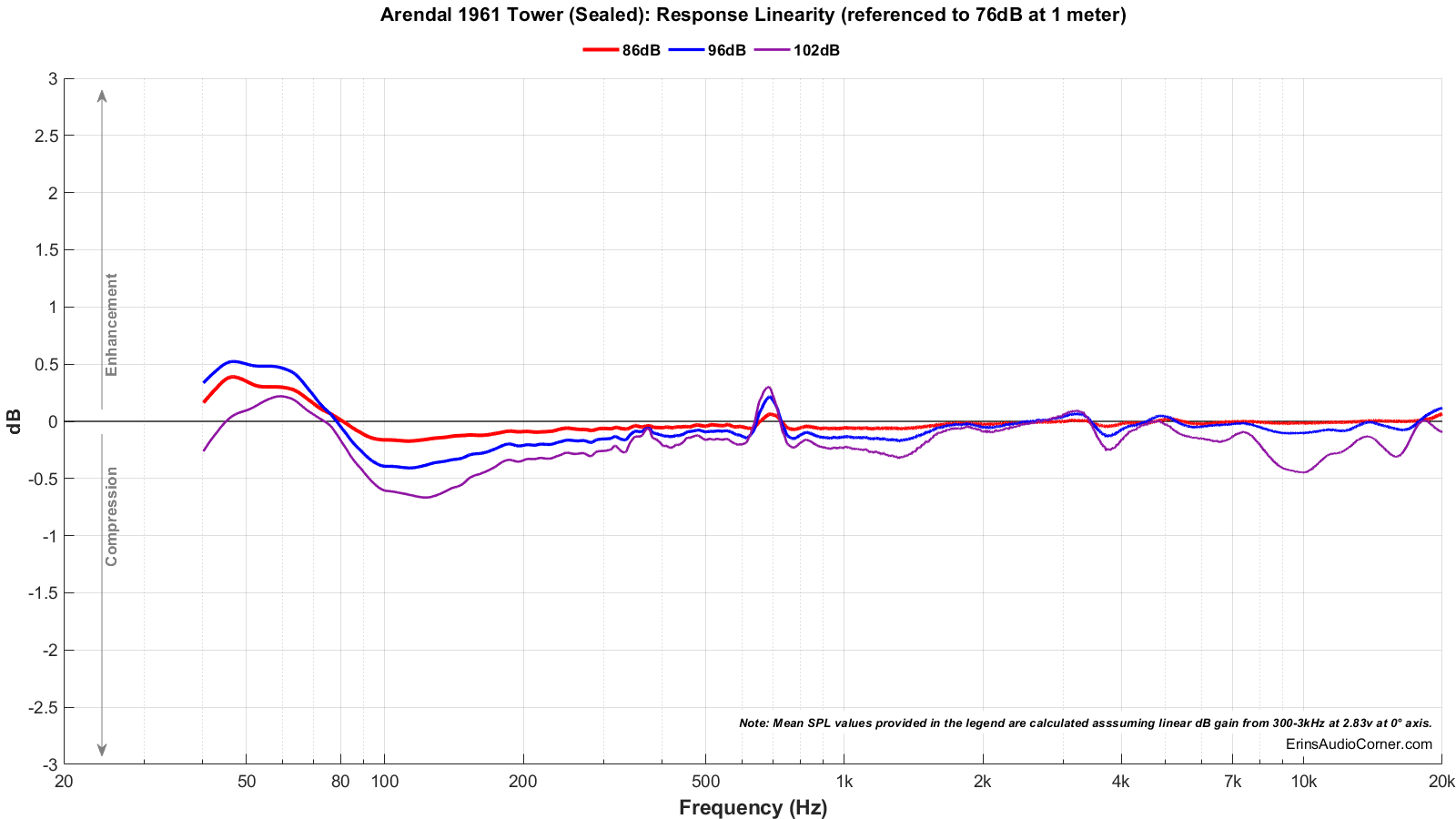
Sealed vs Ported
The speaker was tested in sealed configuration. I did perform an outdoor ground plane check to compare the difference between sealed and ported and have provided that in a section below. Note, however, the response is cut off below 40Hz as the noise floor the day I performed these tests was higher than acceptable to get proper < 30Hz response accuracy. The difference in response above 10kHz is almost certainly for the same reason. When a speaker is more directional and there is less SPL to overcome additional noise, the accuracy diminishes. But, this should give you a general idea of what you get in terms of low frequency response compared to the sealed configuration.
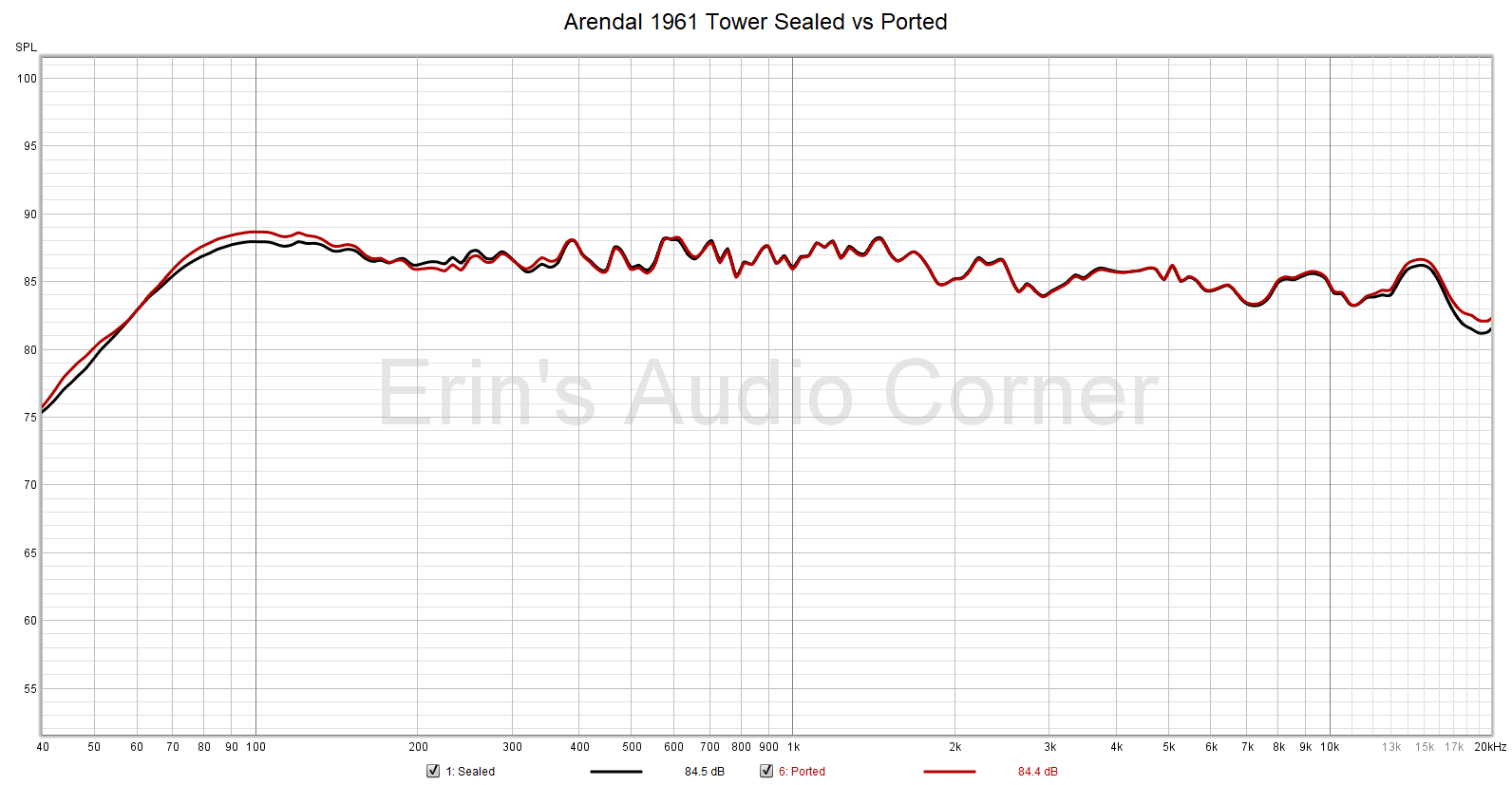
Parting / Random Thoughts
As stated in the Foreword, this written review is purposely a cliff’s notes version. For details about the performance (objectively and subjectively) please watch the YouTube video.
As I discussed previously, the reference axis for measurement in the vertical plane is at the tweeter. The baffle is angled by 5° and, therefore, puts the primary listening axis at this angle, above the tweeter. Why? Well, when you see these speakers, you’ll understand. They are compact tower speakers. The smallest tower speaker I have tested to date. The low height and the location of the tweeter places the tweeter physically below a typical ear position at a typical seated position. However, Arendal made up for this by angling the baffle which aligns the listening axis to this typical seated height. What this means, to me, is that this speaker is designed for the customer who may not have a large listening space or simply prefers a speaker that is less seen and more heard. Personally, I like a big ol’ tower speaker that looks like it would beat you up in a street fight but I understand not everyone does. Nor, does everyone have the space for such a speaker.
Speaking of ‘heard but not seen’ (relatively speaking), this tower speaker can be used in sealed or ported configuration. I tried both and rather liked the sealed version. It did not excite some of the lower frequency room modes and I liked that there was less emphasis in the 100-200Hz region that the ported configuration also results in. You can see the comparison in the above data. Use what works best for you. But also keep in mind that this means you have more luxury in placement of the speaker. No longer do you have to bring them far from the walls. If necessary, you can place them much closer to the walls when in sealed configuration as opposed to placing a ported speaker right near the wall and suffering some response issues (and potentially more wall vibrations). This is all preference, of course. I like that Arendal provides the option here. I think it fits right in-line with the overall design; compact tower that has flexibility in placement for rooms of vary sizes.
Like the Arendal 1961 bookshelf I tested previously (link), this is a very compact tower speaker that has excellent performance at low to high volume. The linearity is really impressive. Compression results are superb. And when you realize just how small this speaker is, the results are even more impressive.
Overall, in my humble opinion, this is an excellent speaker. The size is compact and allows it to go in small rooms but also has enough output for medium sized rooms at full tilt. The cabinet is “dead” and resonance free. Great linearity (again, with the aforementioned caveat). Great horizontal directivity (and, thus, great EQ’ability to season to taste if so desired). Excellent output capability down to that could possibly be ran without a crossover (depending on output needs and low frequency extension). Even better with a proper crossover filter and an accompanying subwoofer. The latter is what I would recommend if ran sealed. Ported could possibly allow you to run without a subwoofer but obviously this is going to be use-case dependent.
Support the Cause
If you find this review helpful and want to help support the cause there are a few ways you can do so below. Your support helps me pay for new items to test, hardware, miscellaneous items needed for testing and costs of the site’s server space and bandwidth. Any help is very much appreciated.
Or using my generic Amazon affiliate link, to purchase items you may need from Amazon.
You can also join my Facebook and YouTube pages if you’d like to follow along with updates.